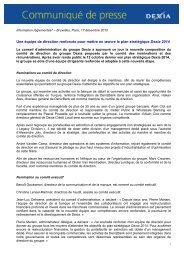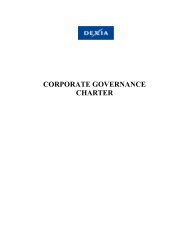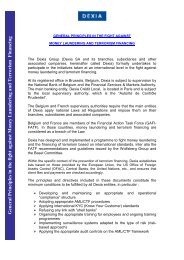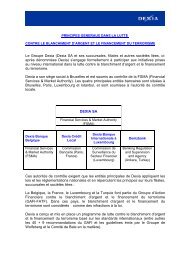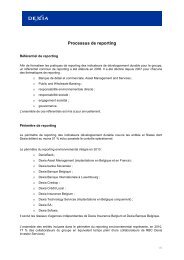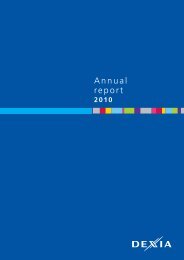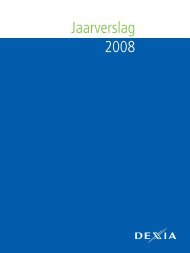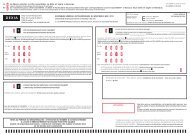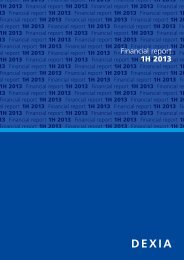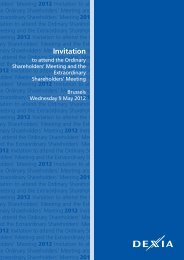Annual report 2009 - Dexia.com
Annual report 2009 - Dexia.com
Annual report 2009 - Dexia.com
- No tags were found...
You also want an ePaper? Increase the reach of your titles
YUMPU automatically turns print PDFs into web optimized ePapers that Google loves.
Notes to the consolidated fi nancial statements1.33. Cash and cash equivalentsFor the purposes of the statement of cash flows, cash andcash equivalents <strong>com</strong>prise balances with less than 3 monthsmaturity included within cash and balances with centralbanks, interbank loans and advances, financial assets held fortrading, financial assets available for sale and financial assetsof the fair value portfolio.1.34. Earnings per shareBasic earnings per share is calculated by dividing net in<strong>com</strong>eavailable to ordinary shareholders by the weighted averagenumber of ordinary shares in issue during the year, excludingthe average number of ordinary shares purchased by <strong>Dexia</strong>and held as treasury shares.For the diluted earnings per share the weighted averagenumber of ordinary shares in issue and the net in<strong>com</strong>e areadjusted to assume conversion of all dilutive potential ordinaryshares, such as convertible debt and share optionsgranted to employees. Potential or contingent share issuancesare treated as dilutive when the derivatives are “in themoney” and their conversion to shares would decrease netearnings per share.1.35. Fair valueThe principles and policies applied in determining the fairvalue of financial instruments is explained in section 4.1.2. SEGMENT REPORTINGA segment is a distinguishable <strong>com</strong>ponent of <strong>Dexia</strong> that isengaged either in providing products or services (businesssegment) or in providing products or services within a particulareconomic environment (geographic segment), which issubject to risks and returns that are different from those ofother segments. Segments with a majority of revenue earnedfrom sales to external customers and whose revenue, resultor assets are 10 per cent or more of all the segments are<strong>report</strong>ed separately.2.1. Business segments(primary segment <strong>report</strong>ing)<strong>Dexia</strong>’s <strong>report</strong>able segments are defined by using the “managementapproach”. These segments reflect <strong>Dexia</strong>'s internalorganisational structure and are used by the management tomake business decisions.As from 1 January <strong>2009</strong>, <strong>Dexia</strong> changed its business <strong>report</strong>ingin line with its new organisation and applied IFRS 8 forthe first time.<strong>Dexia</strong>’s business is now divided in three business lines andone Group Center reflecting the organisational structure of<strong>Dexia</strong> and is <strong>report</strong>ed as follows:• “Retail and Commercial Banking”;• “Public and Wholesale Banking” ;• “Asset management and services” divided in:– “Asset Management”;– “Investor Services”;– “Insurance”;• “Group Center” divided in:– “Treasury”;– “Bond portfolios in run-off”;– “Central assets”.Compared to the previous business segmentation, the mainchanges are:• “Treasury and Financial Markets” is no longer a businessline but is now reallocated to the Group Centerand to operational business lines (Structuring, sales andtrading activities being allocated to corresponding subsegments);• Insurance is no longer distributed between RCB and PWB,but is now part of the newly created AMS which also includesAsset Management and Investor Services;• All bond portfolios in run-off (Public bonds and FSA’s FinancialProducts portfolios previously in PWB; Credit-Spread Portfoliosand trading portfolios previously in TFM) are entirelyreallocated to the Group Center;• FSA insurance is taken out of PWB and included in GroupCenter;• The former PWB activities of Turkey, Luxembourg and Slovakiaare now included in RCB.The basis of measurement of segment profit or loss is notmaterially different in IFRS 8 from IAS 14.Relations between business lines and especially between<strong>com</strong>mercial business lines, financial markets and productionand service centers are subject to retrocession and/or analyticaltransfers, governed by service level agreements based onnormal <strong>com</strong>mercial terms and market conditions. The resultsof each business line also include:• The earnings from <strong>com</strong>mercial transformation, includingthe management costs of this transformation and the Groupequity allocated to this activity on the basis of medium andlong-term outstanding;• Interest on economic capital: economic capital is allocatedto the business lines for internal purposes and the return oneconomic capital is used to measure the performance of eachbusiness line;• Funding cost.2.2. Geographic segments(secondary segment <strong>report</strong>ing)Although <strong>Dexia</strong>’s business segments are managed on aworldwide basis, they operate in five main geographic areasas follows:• Belgium• Luxembourg• Turkey• United States• Others3. RISK MANAGEMENT POLICIESAND HEDGING ACTIVITIESThis section presents information about <strong>Dexia</strong>’s exposure to,and its management and control of risks, in particular theprimary risks associated with its use of financial instruments:• Market risk is exposure to observable market variables suchas interest rates, exchange rates, equity prices and spreads;<strong>Annual</strong> <strong>report</strong> <strong>2009</strong> <strong>Dexia</strong> 119Management <strong>report</strong>Consolidatedfinancial statements<strong>Annual</strong> financial statementsAdditional information



